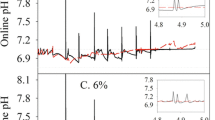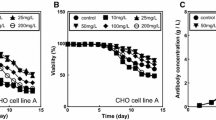Abstract
Experiments, earlier performed in our laboratory, showedthe stimulating effect of butyric acid on monoclonalantibody production by hybridoma cells. Itssimulaneous inhibitory effect on cell growth canhowever compensate for this, so that no increase ofmonoclonal antibody titer might be obtained. We showin this article an experiment with addition of butyricacid in the middle of the growth phase of a batchculture, as a strategy to take real profit of such anaddition by a significant increase of final monoclonalantibody concentration. Indeed, in this way asignificant cell density could be obtained before theaddition of butyric acid, while the remaining culturetime was still sufficiently long for its action,resulting in a two fold increase of final monoclonalantibody titer. The experiment was carried out in a 2 L bioreactor, showing the real practical interest ofsuch an addition for the large scale production ofproteins. Furthermore, analysis of the produced IgG bySDS-PAGE and Western blot did not reveal structuralchanges after stimulation by butyric acid. An originalpoint of our study is the characterization of the cellbehaviour, by flow cytometry and other relatedtechniques, leading to a better insight in the effectof the butyric acid addition on cell growth andmonoclonal antibody production. Although there existsa lot of knowledge about the effects of butyrate oncells in the field of molecular biology, our article isat our knowledge one of the first to show some of itseffects on cell behaviour in bioreactor culture,carried out under perfectly defined and controlledconditions, and with the aim to stimulate monoclonalantibody production.
Similar content being viewed by others
References
Al-Rubeai M, Emery AN, Chalder S and Jan DC (1992) Specific monoclonal antibody production and the cell cycle-comparison of batch, continuous and perfusion cultures. Cytotechnology 98: 85-97.
Boffa LC, Gruss, RJ and Allfrey VG (1981) Manifold effects of sodium butyrate on nuclear function. J Biol Chem 256: 9612-9621.
Chen Z, Yongzhong K and Chen Y (1993) A serum-free medium for hybridoma cell culture. Cytotechnology 11: 169-174.
Cherlet M and Marc A (1999) Hybridoma cell behaviour in continuous culture under hyperosmotic stress. Cytotechnology 29: 71-84.
Cherlet M, Kromenaker SJ and Srienc F (1995) Surface IgG content of murine hybridomas: direct evidence for variation of antibody secretion rates during the cell cycle. Biotechnol Bioeng 47: 535-540.
Chevalot I, Dardenne M, Cherlet M, Engasser JM and Marc A (1995) Effect of sodium butyrate on protein production in different culture systems. In: Spier RE, Griffiths JB and Beuvery EC (eds.) Animal Cell Technology: Developments towards the 21st Century (pp. 143-147) Kluwer Academic Publishers, Dordrecht.
Dardenne M (1995) Cultures d'hybridomes en réacteur agité: études cinétiques, optimisation et modélisation de cultures semifermées. Ph.D. thesis INPL, Nancy, France.
Dorner AJ, Wasley LC and Kaufman RJ (1989) Increased synthesis of secreted protein induces expression of glucose-regulated proteins in butyrate-treated Chinese hamster ovary cells. J Biol Chem 264: 20602-20607.
Ganne V, Guerin P, Faure T and Mignot G (1991) Increased expression of factor VIII by butyrate in Chinese hamster ovary cells. In: Spier RE, Griffiths JB and Meignier B (eds.) Production of Biologicals by Animal Cells in Culture (pp. 104-106) Butterworth-Heinemann, Oxford.
Gebert C and Gray PP (1991) A screening experiment of media supplements on CHO cells. In: Spier RE, Griffiths JB and Meignier B (eds.) Production of Biologicals by Animal Cells in Culture (pp. 76-78) Butterworth-Heinemann, Oxford.
Kromenaker SJ and Srienc F (1991) Cell-cycle-dependent protein accumulation by producer and nonproducer murine hybridoma cell lines: a population analysis. Biotechnol Bioeng 38: 665-677.
Kruh J (1982) Effects of sodium butyrate, a new pharmalogical agent, on cells in culture. Mol Cell Biochem 42: 65-82.
Lucocq JM and Warren G (1987) Fragmentation and partitioning of the Golgi apparatus during mitosis in HeLa cells. EMBO J 6: 3239-3246.
Oh SKW, Vig P, Chua F, Teo, WK and Yap MgS (1993) Substantial overproduction of antibodies by applying osmotic pressure and sodium butyrate. Biotechnol Bioeng 42: 601-610.
Oster T, Thioudellet C, Chevalot I, Masson C, Wellman M, Marc A and Siest G (1993) Induction of recombinant γ-glutamyl transferase by sodium butyrate in transfected V79 and CHO Chinese hamster cells. Biochem Biophys Res Commun 193: 406-412.
Palermo DP, DeGraaf ME, Marotti KR, Rehberg E and Post LE (1991) Production of analytical quantities of recombinant proteins in Chinese hamster ovary cells using sodium butyrate to elevate gene expression. J Biotechnol 19: 35-48.
Renard JM, Spagnoli R, Mazier C, Salles MF and Mandine E (1988) Evidence that monoclonal antibody production kinetics is related to the integral of the viable cells curve in batch systems. Biotechnol Lett 10: 91-96.
Suzuki E and Ollis DF (1990) Enhanced antibody production at slower growth rates: experimental demonstration and a simple structured model. Biotechnol Prog 6: 231-236.
Takizawa PA, Yucel JK, Veit B, Faulkner DJ, Deerinck T, Soto G, Ellisman M and Malhotra V (1993) Complete vesiculation of Golgi membranes and inhibition of protein transport by a novel sea sponge metabolite, ilimaquinone. Cell 73: 1079-1090.
Author information
Authors and Affiliations
Rights and permissions
About this article
Cite this article
Cherlet, M., Marc, A. Stimulation of monoclonal antibody production of hybridoma cells by butyrate: evaluation of a feeding strategy and characterization of cell behaviour. Cytotechnology 32, 17–29 (2000). https://doi.org/10.1023/A:1008069523163
Issue Date:
DOI: https://doi.org/10.1023/A:1008069523163




